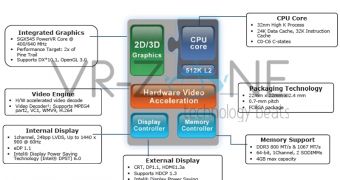Intel may have just unveiled the Oak Trail Atom processor for tablets, but the company is also working hard to deliver the Cedarview in a timely fashion, with some details on the graphics having finally been revealed.
With the way things are going, it is likely that it won't take long for every Intel CPU, and eventually every other such chip in the industry, to have some sort of built-in GPU.
The Sandy Bridge second-generation Core series already boasts superior graphics to the ones that were in power until late last year.
Now, it appears that a certain other series of processors, the Atom one to be more precise, will receive some 2D and 3D support of its own.
This seems to be Intel's response to how the current IT and especially the laptop and tablet market is moving in a direction that favors SoC (system-on-chip) devices and pretty much any chips with wide feature integration.
It is already known that the Cedar Trail platform will include two units, at least at first, with two cores each and frequencies of 1.86 GHz (D2500) and 2.13 GHz (D2700), when it debuts later this year.
One asset of the integrated, PowerVR SGX545-based graphics cores, is that DirectX 10.1 is supported, which promises smooth and good visuals for netbooks and tablets.
The GPU is also capable, theoretically, of OpenGL 3.2 support, although the Santa Clara, California-based chip maker appears to have settled for 'just' OpenGL 3.0.
What's more, hardware acceleration exists for not just the H.264 codec, but also WMV9, VCI, MPEG-2 and MPEG-4 part 2.
The solution within the Atom D2500 will probably be called GMA (graphics media accelerator) 500, while the one in the D2700 will likely bear the name of GMA 600.
Finally, their own clock speed will be of 640 MHz for the desktop chips and 400 MHz for the laptop units.
As for memory support, dual-channel RAM is still not supported, but single-channel DDR3 is, with the maximum capacity implementable being of 4 GB.

 14 DAY TRIAL //
14 DAY TRIAL //